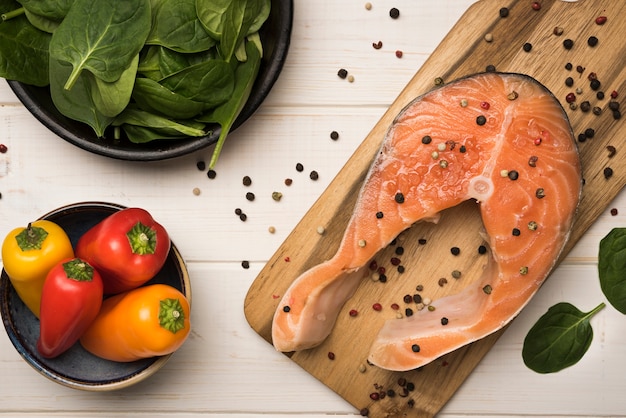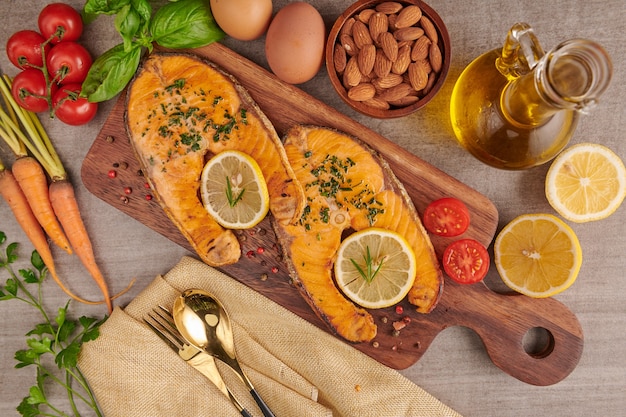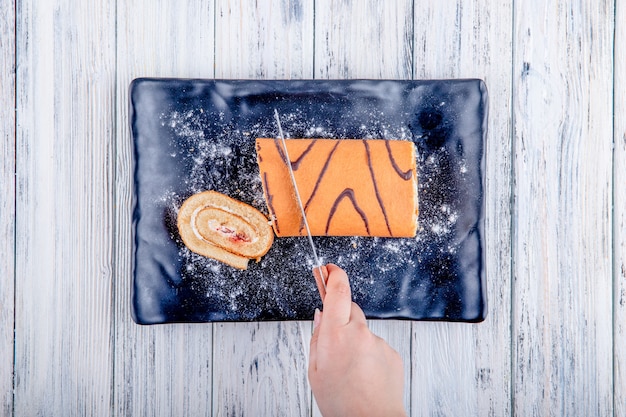You know that feeling – you're craving a delicious, healthy meal, and salmon pops into your mind. But then the doubt creeps in. You've heard horror stories of dry, flaky salmon, and you're not sure you're up for the challenge. Fear not, my friend! I've been there, and with a few simple tips and tricks, you'll be whipping up a symphony of flavour in your very own kitchen.
This isn't just another run-of-the-mill salmon recipe guide. We're going on a journey together, from choosing the perfect fish to achieving that gorgeous, flaky texture without a single dry bite. Ready? Let's dive in!
(Part 1) The Salmon – Choosing Your Weapon

First things first, let's talk salmon. It's the star of the show, so you want to choose wisely. Whether you're a seasoned chef or a kitchen newbie, picking the right salmon makes all the difference.
1. The Fresh Factor
Now, I'm a big believer in fresh, local salmon whenever possible. Head down to your local fishmonger and chat with them, they're a wealth of knowledge! If you're not near the coast, don't fret – frozen salmon is perfectly fine. Just make sure it's high quality, with a vibrant colour and firm texture. Here’s what to look for:
wild salmon: This is the real deal, a powerhouse of flavour, sustainably caught, and worth the extra pennies. It often has a more robust texture and a richer taste.
farmed salmon: A more accessible option, it's readily available in supermarkets. Look for a vibrant pink to orange colour, indicating a healthy fish.
sockeye salmon: Oh, the Sockeye! This beauty is known for its deep red flesh and incredibly rich flavour. It's truly a delicacy, and if you can find it, I highly recommend giving it a try.
2. Size Matters
Don't be intimidated by the size of your salmon! You can bake individual fillets, perfect for a quick weeknight meal, or tackle a whole side of salmon for a showstopping dinner party. Just adjust your baking time accordingly – we'll get to that later.
3. Skin On or Skin Off?
This is a personal preference, and both have their merits. I usually prefer to bake salmon with the skin on. It creates a barrier, preventing the salmon from drying out during cooking. Plus, it gives the fish a lovely golden-brown colour. Plus, it’s super easy to remove after cooking – just slide a fork under the skin and it will peel right off. However, if you're not a fan of skin, feel free to remove it before baking.
(Part 2) Getting Your Oven Ready

Now, let's get your oven prepped and ready for our salmon star.
1. Preheat It, Please
Always preheat your oven! This is crucial for ensuring even cooking. Aim for around 180°C (350°F).
2. The Baking Sheet – Your Salmon's Throne
Next, we need a baking sheet for our salmon to rest upon. I'm a big fan of lining my baking sheet with parchment paper. It makes for a breeze when cleaning up later, and it prevents the salmon from sticking.
3. Don't Forget the Rack
Finally, for those perfect results, we're going to use a wire rack. Place it on top of your baking sheet. This allows hot air to circulate freely around the fish, ensuring it cooks evenly.
(Part 3) Seasoning Secrets – Unlocking the Flavour

Here comes the fun part! Seasoning is where you really get to unleash your inner chef and bring out the best in your salmon.
1. Salt and Pepper - The Essential Duo
This dynamic duo is the foundation of any good salmon dish. Season generously, both inside and out. Don't be shy – the salt brings out the salmon's natural flavour, and a touch of pepper adds a delightful kick.
2. A Sprinkling of Herbs and Spices
Now, this is where you can get creative. Here are a few of my tried-and-true favourites, but feel free to experiment and create your own signature blend:
Lemon and Dill: A classic for a reason! The bright, citrusy notes of lemon complement the delicate flavour of dill perfectly. This combination is fresh and light, perfect for a simple salmon bake.
Garlic and Rosemary: Oh, the aroma! Garlic and rosemary create a stunning depth of flavour that's both earthy and comforting. It's a winning combination that will have your kitchen smelling divine.
Chili Flakes and Paprika: For those who enjoy a bit of heat, chili flakes and paprika bring a smoky, spicy kick to the party. Be warned – a little goes a long way!
Ginger and Soy Sauce: This Asian-inspired combination delivers a burst of flavour with a hint of sweetness. It pairs well with a side of stir-fried vegetables.
3. Citrus Zest
A touch of citrus zest adds a beautiful brightness and fragrance to your salmon. Lemon, lime, or even orange zest – it's your call!
(Part 4) Baking Time – The Countdown Begins
We’re almost there! Let's talk about the crucial part – baking time.
1. The Golden Rule
The baking time depends on the thickness of your salmon fillet. As a general rule, aim for about 10-12 minutes per inch of thickness.
2. The Flip Test
Once your salmon is cooked, it'll be flaky and opaque. To check for doneness, gently use a fork to flake the fish. If it flakes easily, it's ready!
3. Don't Overcook!
The biggest mistake people make is overcooking their salmon. It's easy to do, so keep a close eye on it. You want it to be cooked through, but still moist and tender. overcooked salmon will be dry and crumbly.
(Part 5) Glazing for Extra Wow Factor
Now, for a touch of extra flavour and visual appeal, let's talk glazes. These are optional, but they take your salmon to the next level!
1. Honey and Soy Glaze
This glaze is sweet, savory, and a little bit umami – a flavour combination that just hits the spot! Whisk together honey, soy sauce, and a touch of sesame oil. Brush the glaze over the salmon during the last few minutes of baking, allowing it to caramelize and create a beautiful, glossy finish.
2. Lemon and Herb Glaze
This glaze is light and refreshing, perfect for a summery dish. Mix together lemon juice, olive oil, fresh herbs like dill or parsley, and a pinch of salt and pepper. Brush the glaze over the salmon before baking, and it will infuse the salmon with a burst of bright flavour.
(Part 6) Serving Time – Let's Eat!
Your salmon is ready, and it's time to enjoy the fruits of your labour. Let's make this a presentation worth remembering.
1. Presentation Matters
Even the simplest salmon dish can look elegant with a little effort. Serve it on a bed of leafy greens, perhaps some baby spinach or arugula, with a squeeze of lemon or a drizzle of olive oil. You could also arrange a colourful mix of roasted vegetables around the fish, creating a visually appealing dish.
2. side dishes Galore
Salmon is incredibly versatile and pairs well with a variety of side dishes. Here are a few ideas to get your creative juices flowing:
Roasted vegetables: roasted asparagus, broccoli, or Brussels sprouts offer a delightful combination of textures and flavours.
Rice or quinoa: These grains provide a hearty and comforting base for your salmon.
Salad: A fresh salad with a light vinaigrette balances the richness of the salmon, creating a refreshing contrast.
(Part 7) Leftover Love – No Waste Allowed
Sometimes we cook a little too much, or maybe you just want to save some for later. Here's how to handle those leftover salmon treasures.
1. Reheating Perfection
If you have leftover salmon, you can easily reheat it in the oven or microwave. Wrap it in foil to prevent it from drying out. For the oven, simply bake it at a low temperature (around 150°C or 300°F) for about 10 minutes. In the microwave, heat it for 30 seconds at a time, until warmed through.
2. Salmon Salad Anyone?
Flake your leftover salmon and toss it into a salad with some chopped vegetables, herbs, and a light vinaigrette. It's a quick and delicious way to use up leftover salmon and create a refreshing meal.
3. Salmon Sandwiches
Who doesn't love a good salmon sandwich? Add a dollop of cream cheese and some fresh herbs to your leftover salmon, and enjoy a tasty and satisfying lunch.
(Part 8) Troubleshooting – Tackling Baking Issues
Even the most seasoned chefs have their moments. Here are some common baking problems and how to avoid them:
1. Dry Salmon – A Common Mishap
If your salmon is dry, it's likely that you overcooked it. Next time, try reducing the baking time by a few minutes. You can also consider wrapping your salmon in foil during the last few minutes of baking to help retain moisture.
2. Undercooked Salmon – Not Quite There Yet
If your salmon is undercooked, it'll be translucent and have a raw feel. Simply return it to the oven for a few more minutes until it is opaque and flaky. It's always better to err on the side of caution and cook it a little longer than to risk undercooked salmon.
3. Sticking Salmon – A Sticky Situation
If your salmon sticks to the baking sheet, you might not have used enough oil or parchment paper. Next time, be sure to grease your pan well with olive oil or butter, or use parchment paper to line your pan.
(Part 9) Recipes – Inspiration for Your Next Salmon Bake
Now, let's get our hands dirty and try out some recipes! These are simple, flavourful, and perfect for any occasion.
1. Easy Lemon Dill Salmon
Ingredients:
1 salmon fillet (about 6-8 ounces)
1 tablespoon olive oil
1 tablespoon lemon juice
1 tablespoon fresh dill, chopped
Salt and pepper to taste
Instructions:
1. Preheat your oven to 180°C (350°F).
2. Line a baking sheet with parchment paper.
3. Place the salmon fillet on the prepared baking sheet.
4. In a small bowl, whisk together the olive oil, lemon juice, dill, salt, and pepper.
5. Pour the mixture over the salmon, ensuring it's coated evenly.
6. Bake for 10-12 minutes, or until the salmon is cooked through and flakes easily with a fork.
7. Serve with your favourite side dishes.
2. Garlic and Herb Roasted Salmon
Ingredients:
1 salmon fillet (about 6-8 ounces)
1 tablespoon olive oil
2 cloves garlic, minced
1 teaspoon rosemary, chopped
1/2 teaspoon thyme, chopped
Salt and pepper to taste
Instructions:
1. Preheat your oven to 180°C (350°F).
2. Line a baking sheet with parchment paper.
3. Place the salmon fillet on the prepared baking sheet.
4. In a small bowl, combine the olive oil, garlic, rosemary, thyme, salt, and pepper.
5. Rub the mixture all over the salmon, ensuring it's evenly coated.
6. Bake for 10-12 minutes, or until the salmon is cooked through and flakes easily with a fork.
7. Serve with your favourite side dishes.
3. Honey Glazed Salmon
Ingredients:
1 salmon fillet (about 6-8 ounces)
1 tablespoon honey
1 tablespoon soy sauce
1/2 teaspoon sesame oil
Salt and pepper to taste
Instructions:
1. Preheat your oven to 180°C (350°F).
2. Line a baking sheet with parchment paper.
3. Place the salmon fillet on the prepared baking sheet.
4. In a small bowl, whisk together the honey, soy sauce, and sesame oil.
5. Brush the glaze over the salmon, ensuring it's evenly coated.
6. Bake for 10-12 minutes, or until the salmon is cooked through and flakes easily with a fork.
7. During the last few minutes of baking, brush the salmon with the remaining glaze to allow it to caramelize.
8. Serve with your favourite side dishes.
(Part 10) FAQs – Answers to Your Burning Questions
You've got questions? I've got answers!
1. Can I bake salmon with the skin on?
Absolutely! baking salmon with the skin on helps to keep it moist. It can be easily removed after cooking.
2. How do I know when my salmon is cooked?
The salmon will be flaky and opaque when cooked. You can use a fork to gently flake the fish to check. If it flakes easily with a little resistance, it's done.
3. What happens if I overcook my salmon?
Overcooked salmon will be dry and flaky. Try reducing the baking time by a few minutes next time. You can also wrap it in foil for the last few minutes of baking to retain moisture.
4. Can I freeze leftover salmon?
Yes, you can freeze leftover salmon for up to 3 months. Simply wrap it tightly in plastic wrap and then foil. When you're ready to use it, thaw it in the refrigerator overnight.
5. What are some healthy and delicious side dishes for salmon?
Salmon pairs well with roasted vegetables, rice, quinoa, or a fresh salad. Get creative and try different combinations!
And there you have it, your ultimate guide to perfectly baked salmon in the oven. From choosing the right salmon to mastering the art of glazing, you now have all the tools you need to create a delicious and impressive dish. So, go on, grab your ingredients, and get baking! I promise, you won't be disappointed. Happy cooking!
Everyone is watching

How to Cook Frozen Lobster Tails Perfectly: A Step-by-Step Guide
RecipesLobster. Just the word conjures up images of lavish meals, special occasions, and a taste of luxury. But let's...

Pork Fillet Cooking Time: How Long to Cook It Perfectly
RecipesPork fillet, or tenderloin as it's sometimes called, is a real favourite in our house. It's so versatile, and...

Pigs in a Blanket Cooking Time: How Long to Bake for Perfect Results
RecipesAh, pigs in a blanket. Just the name conjures up images of those delightful little parcels of crispy pastry en...

The Ultimate Guide to Cooking Delicious Frankfurters
RecipesLet's face it, we all love a good frankfurter. It's a classic, simple, and always satisfying. But let's be rea...

Wolf Meat Recipes: A Guide to Cooking Wild Game
RecipesLet's be honest, you don't see wolf meat at your local butcher shop every day. It's a bit of a wild card, but ...
